What Does the Sustainability-Risk Interaction Look Like? Exploring Nuanced Relationships in Emerging Economy Sustainability Initiatives
Abstract
1. Introduction
- Does sustainability introduce new and unexpected risks into food supply chains?
- If so, what is the nature of these sustainability-induced risks?
- How do sustainability and risk interact to influence managerial decision making and ultimately the viability of sustainability programs?
2. Theoretical Background: Understanding the Sustainability-Risk Interaction
2.1. The Sustainability-Risk Interaction
2.2. Theoretical Framework: The Dynamics of Sustainability-Risk Interactions
2.2.1. Systems Thinking
2.2.2. Chaos Theory
2.2.3. Theory of Constraints
3. Research Methods
3.1. Sample and Context
3.1.1. Country Selection
3.1.2. Industry Selection
3.1.3. Company Selection
3.2. Data Collection
3.3. Data Analysis
3.4. Reliability and Validity of the Research
4. Findings and Discussion
4.1. The Nuanced Nature of Sustainability-Induced Risks
4.1.1. Behavioral Risks
4.1.2. Opportunism Risks
4.1.3. Organizational Routines Risks
4.1.4. Safety and Traceability Routines Risks
4.1.5. Systems Design Risks
5. Conclusions and Contributions
5.1. Theoretical Implications
5.2. Managerial Implications
5.3. Limitations and Directions for Further Research
Author Contributions
Funding
Conflicts of Interest
Appendix A
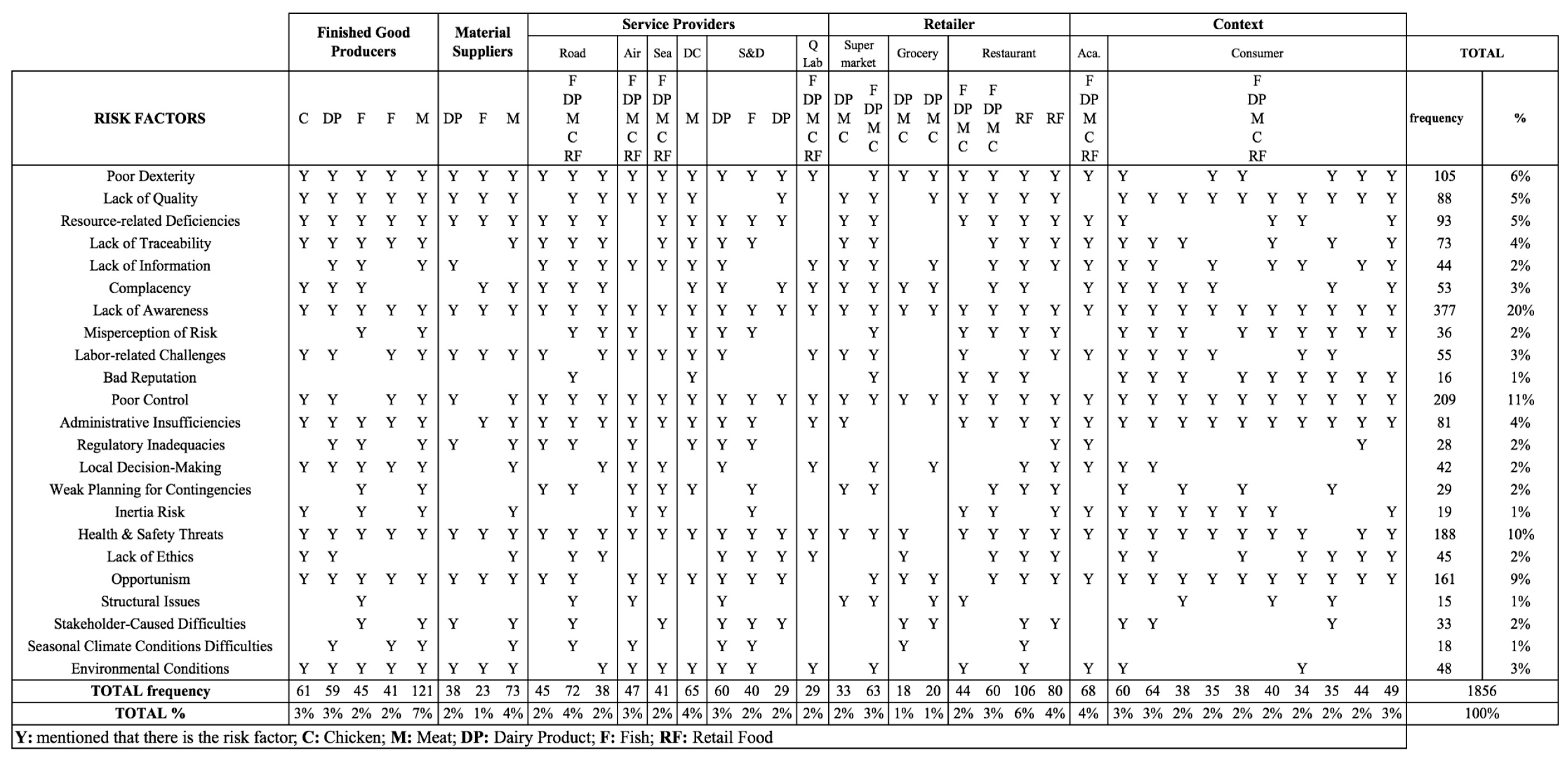
References
- Elkington, J. Cannibals with Forks: The Triple Bottom Line of 21st Century; Capstone Publishing Ltd.: Oxford, UK, 1997. [Google Scholar]
- Fawcett, S.E.; Brockhaus, S.; Knemeyer, A.M.; Fawcett, A.M. Sustainability as strategy: Caught in the luxury trap. Supply Chain Manag. Rev. 2015, 19, 16–25. [Google Scholar]
- Brockhaus, S.; Fawcett, S.E.; Knemeyer, A.M.; Fawcett, A.M. Motivations for environmental and social consciousness: Reevaluating the sustainability-based view. J. Clean. Prod. 2017, 143, 933–947. [Google Scholar] [CrossRef]
- O’Callaghan, T. Disciplining multinational enterprises: The regulatory power of reputation risk. Glob. Soc. 2007, 21, 95–117. [Google Scholar] [CrossRef]
- Ganesan, S.; George, M.; Jap, S.; Palmatier, R.W.; Weitz, B. Supply chain management and retailer performance: Emerging trends, issues, and implications for research and practice. J. Retail. 2009, 85, 84–94. [Google Scholar] [CrossRef]
- Ko, E.; Hwang, Y.K.; Kim, E.Y. Green marketing’functions in building corporate image in the retail setting. J. Bus. Res. 2013, 66, 1709–1715. [Google Scholar] [CrossRef]
- Godfrey, P.C.; Merrill, C.B.; Hansen, J.M. The relationship between corporate social responsibility and shareholder value: An empirical test of the risk management hypothesis. Strateg. Manag. J. 2009, 30, 425–445. [Google Scholar] [CrossRef]
- Gladwin, T.N.; Kennelly, J.J.; Krause, T.S. Shifting paradigms for sustainable development: Implications for management theory and research. Acad. Manag. Rev. 1995, 20, 874–907. [Google Scholar] [CrossRef]
- Hofmann, H.; Busse, C.; Bode, C.; Henke, M. A foundation of sustainability related supply chain risks in stakeholder theory. In Efficiency and Logistics; Springer: Berlin/Heidelberg, Germany, 2013; pp. 185–196. [Google Scholar]
- Anderson, D.R.; Anderson, K.E. Sustainability risk management. Risk Manag. Insur. Rev. 2009, 12, 25–38. [Google Scholar] [CrossRef]
- Hofmann, H.; Busse, C.; Bode, C.; Henke, M. Sustainability-related supply chain risks: Conceptualization and management. Bus. Strategy Environ. 2014, 23, 160–172. [Google Scholar] [CrossRef]
- Carter, C.R.; Rogers, D.S. A framework of sustainable supply chain management: Moving toward new theory. Int. J. Phys. Distrib. Logist. Manag. 2008, 38, 360–387. [Google Scholar] [CrossRef]
- Carter, C.R.; Liane Easton, P. Sustainable supply chain management: Evolution and future directions. Int. J. Phys. Distrib. Logist. Manag. 2011, 41, 46–62. [Google Scholar] [CrossRef]
- Singhal, P.; Agarwal, G.; Mittal, M.L. Supply chain risk management: Review, classification and future research directions. Int. J. Bus. Sci. Appl. Manag. 2011, 6, 15–42. [Google Scholar]
- Hassini, E.; Surti, C.; Searcy, C. A literature review and a case study of sustainable supply chains with a focus on metrics. Int. J. Prod. Econ. 2012, 140, 69–82. [Google Scholar] [CrossRef]
- Seuring, S.; Müller, M. From a literature review to a conceptual framework for sustainable supply chain management. J. Clean. Prod. 2008, 16, 1699–1710. [Google Scholar] [CrossRef]
- Luo, J.; Ji, C.; Qiu, C.; Jia, F. Agri-food supply chain management: Bibliometric and content analyses. Sustainability 2018, 10, 1573. [Google Scholar] [CrossRef]
- Taylor, K. Chipotle’s Stock Is down after Claims of Food-Poisoning Incidents in Manhattan. Available online: http://www.businessinsider.com/chipotles-stock-down-after-reports-of-another-food-poisoning-2016-7 (accessed on 15 September 2016).
- Krysiak, F.C. Risk management as a tool for sustainability. J. Bus. Ethics 2009, 85, 483–492. [Google Scholar] [CrossRef]
- Prakash, S.; Soni, G.; Rathore, A.P.S. A critical analysis of supply chain risk management content: A structured literature review. J. Adv. Manag. Res. 2017, 14, 69–90. [Google Scholar] [CrossRef]
- Ho, W.; Zheng, T.; Yildiz, H.; Talluri, S. Supply chain risk management: A literature review. Int. J. Prod. Res. 2015, 53, 5031–5069. [Google Scholar] [CrossRef]
- Rangel, D.A.; de Oliveira, T.K.; Leite, M.S.A. Supply chain risk classification: Discussion and proposal. Int. J. Prod. Res. 2015, 53, 6868–6887. [Google Scholar] [CrossRef]
- Song, W.; Ming, X.; Liu, H.C. Identifying critical risk factors of sustainable supply chain management: A rough strength-relation analysis method. J. Clean. Prod. 2017, 143, 100–115. [Google Scholar] [CrossRef]
- Giannakis, M.; Papadopoulos, T. Supply chain sustainability: A risk management approach. Int. J. Prod. Econ. 2016, 171, 455–470. [Google Scholar] [CrossRef]
- Jüttner, U. Supply chain risk management: Understanding the business requirements from a practitioner perspective. Int. J. Logist. Manag. 2005, 16, 120–141. [Google Scholar] [CrossRef]
- Olson, D.L.; Wu, D.D. A Review of Enterprise Risk Management in Supply Chain. Kybernetes 2010, 39, 694–706. [Google Scholar] [CrossRef]
- Wolf, J. Sustainable supply chain management integration: A qualitative analysis of the german manufacturing industry. J. Bus. Ethics 2011, 102, 221–235. [Google Scholar] [CrossRef]
- Barreto, I. Dynamic capabilities: A review of past research and an agenda for the future. J. Manag. 2010, 36, 256–280. [Google Scholar] [CrossRef]
- Churchman, C. The Systems Approach; West: West Whiteland Township, PA, USA; Delta: Atlanta, GA, USA, 1968. [Google Scholar]
- Gammelgaard, B. The Systems Approach in Logistics; Institute for Logistics and Transport, Copenhagen Business School: Frederiksberg, Denmark, 1997; pp. 9–20. [Google Scholar]
- Senge, P.M. The Fifth Discipline: The Art and Practice of the Learning Organization; Broadway Business: New York, NY, USA, 2006. [Google Scholar]
- Cooper, M.C.; Lambert, D.M.; Pagh, J.D. Supply chain management: More than a new name for logistics. Int. J. Logist. Manag. 1997, 8, 1–14. [Google Scholar] [CrossRef]
- Warren, K.; Franklin, C.; Streeter, C.L. New directions in systems theory: Chaos and complexity. Soc. Work 1998, 43, 357–372. [Google Scholar] [CrossRef]
- Choi, T.Y.; Dooley, K.J.; Rungtusanatham, M. Supply networks and complex adaptive systems: Control versus emergence. J. Oper. Manag. 2001, 19, 351–366. [Google Scholar] [CrossRef]
- Pathak, S.D.; Day, J.M.; Nair, A.; Sawaya, W.J.; Kristal, M.M. Complexity and adaptivity in supply networks: Building supply network theory using a complex adaptive systems perspective. Decis. Sci. 2007, 38, 547–580. [Google Scholar] [CrossRef]
- Wilding, R.D. Chaos theory: Implications for supply chain management. Int. J. Logist. Manag. 1998, 9, 43–56. [Google Scholar] [CrossRef]
- Tetenbaum, T.J. Shifting paradigms: From Newton to chaos. Organ. Dyn. 1998, 26, 21–32. [Google Scholar] [CrossRef]
- Giammona, C.; Patton, L. Chipotle’s Biggest Strength Is Suddenly Its Biggest Weakness. Available online: http://www.bloomberg.com/news/articles/2015-12-08/chipotle-s-greatest-strength-is-now-its-greatest-weakness-too (accessed on 15 September 2016).
- Goldratt, E.M.; Cox, J. The Goal: Excellence in Manufacturing; North River Press: Croton-on-Hudson, NY, USA, 1984. [Google Scholar]
- Fawcett, S.E.; Pearson, J.N. Understanding and applying constraint management in today’s manufacturing environments. Prod. Inventory Manag. J. 1991, 32, 46. [Google Scholar]
- Spencer, M.S.; Cox, J.F. Optimum production technology (OPT) and the theory of constraints (TOC): Analysis and genealogy. Int. J. Prod. Res. 1995, 33, 1495–1504. [Google Scholar] [CrossRef]
- Blackstone, J.H. Theory of constraints—A status report. Int. J. Prod. Res. 2010, 39, 1053–1080. [Google Scholar] [CrossRef]
- Rahman, S.U. The theory of constraints’ thinking process approach to developing strategies in supply chains. Int. J. Phys. Distrib. Logist. Manag. 2002, 32, 809–828. [Google Scholar] [CrossRef]
- Fawcett, S.E.; Fawcett, A.M.; Watson, B.J.; Magnan, G.M. Peeking inside the black box: Toward an understanding of supply chain collaboration dynamics. J. Suppl. Chain Manag. 2012, 48, 44–72. [Google Scholar] [CrossRef]
- Mentzer, J.T.; DeWitt, W.; Keebler, J.S.; Min, S.; Nix, N.W.; Smith, C.D.; Zacharia, Z.G. Defining supply chain management. J. Bus. Logist. 2001, 22, 1–25. [Google Scholar] [CrossRef]
- Yin, R.K. Case Study Research: Design and Methods, 4th ed.; Sage publications Inc.: Thousand Oaks, CA, USA, 2009. [Google Scholar]
- Creswell, J.W. Qualitative Inquiry and Research Design: Choosing among Five Approaches; Sage publications: Thousand Oaks, CA, USA, 2007. [Google Scholar]
- Sheth, J.N. Impact of emerging markets on marketing: Rethinking existing perspectives and practices. J. Mark. 2011, 75, 166–182. [Google Scholar] [CrossRef]
- Jia, F.; Zuluaga, L.; Bailey, A.; Rueda, X. Agricultural supply chain management in emerging economies: A review of literature. J. Clean. Prod. 2018, 189, 263–278. [Google Scholar] [CrossRef]
- Rapoza, K. 19 Reasons Why Emerging Markets belong in Your Portfolio. Available online: https://www.forbes.com/sites/kenrapoza/2011/07/08/emerging-markets-coke-vale-baidu-petrobras-ishares/2011 (accessed on 15 September 2016).
- Silvestre, B.S. A hard nut to crack! Implementing supply chain sustainability in an emerging economy. J. Clean. Prod. 2015, 96, 171–181. [Google Scholar] [CrossRef]
- Eren-Erdogmus, I.; Cobanoglu, E.; Yalcın, M.; Ghauri, P.N. Internationalization of emerging market firms: The case of Turkish retailers. Int. Mark. Rev. 2010, 27, 316–337. [Google Scholar] [CrossRef]
- Ozsomer, A.; Bodur, M.; Cavusgil, S.T. Marketing standardisation by multinationals in an emerging market. Eur. J. Mark. 1991, 25, 50–64. [Google Scholar] [CrossRef]
- Rajurkar, S.W.; Jain, R. Food supply chain management: Review, classification and analysis of literature. Int. J. Integr. Suppl. Manag. 2011, 6, 33–72. [Google Scholar] [CrossRef]
- Akkerman, R.; Farahani, P.; Grunow, M. Quality, safety and sustainability in food distribution: A review of quantitative operations management approaches and challenges. OR Spectr. 2010, 32, 863–904. [Google Scholar] [CrossRef]
- Cavinato, J.L. Supply chain logistics risks: From the back room to the board room. Int. J. Phys. Distrib. Logist. Manag. 2004, 34, 383–387. [Google Scholar] [CrossRef]
- Wognum, P.N.; Bremmers, H.; Trienekens, J.H.; van der Vorst, J.G.; Bloemhof, J.M. Systems for sustainability and transparency of food supply chains–current status and challenges. Adv. Eng. Inform. 2011, 25, 65–76. [Google Scholar] [CrossRef]
- Eisenhardt, K.M. Building theories from case study research. Acad. Manag. Rev. 1989, 14, 532–550. [Google Scholar] [CrossRef]
- Fawcett, S.E.; Waller, M.A.; Miller, J.W.; Schwieterman, M.A.; Hazen, B.T.; Overstreet, R.E. A trail guide to publishing success: Tips on writing influential conceptual, qualitative, and survey research. J. Bus. Logist. 2014, 35, 1–16. [Google Scholar] [CrossRef]
- Pettigrew, A.M. Longitudinal field research on change: Theory and practice. Organ. Sci. 1990, 1, 267–292. [Google Scholar] [CrossRef]
- Houghton, J.R.; Rowe, G.; Frewer, L.J.; Van Kleef, E.; Chryssochoidis, G.; Kehagia, O.; Korzen-Bohr, S.; Lassen, J.; Pfenning, U.; Strada, A. The quality of food risk management in Europe: Perspectives and priorities. Food Policy 2008, 33, 13–26. [Google Scholar] [CrossRef]
- Locke, K. Grounded Theory in Management Research; Sage: Newcastle upon Tyne, UK, 2001. [Google Scholar]
- Pratt, M.G. Fitting oval pegs into round holes: Tensions in evaluating and publishing qualitative research in top-tier North American journals. Organ. Res. Methods 2008, 11, 481–509. [Google Scholar] [CrossRef]
- Miles, M.B.; Huberman, A.M. Qualitative Data Analysis: An Expanded Sourcebook; Sage: Newcastle upon Tyne, UK, 1994. [Google Scholar]
- Haavisto, I.; Kovács, G. Perspectives on sustainability in humanitarian supply chains. Dis. Prev. Manag. Int. J. 2014, 23, 610–631. [Google Scholar] [CrossRef]
- Seuring, S.; Gold, S. Conducting content-analysis based literature reviews in supply chain management. Suppl. Chain Manag. Int. J. 2012, 17, 544–555. [Google Scholar] [CrossRef]
- Williamson, O.E. Markets and Hierarchies; Free Press: New York, NY, USA, 1975. [Google Scholar]
- Brockhaus, S.; Fawcett, S.E.; Kersten, W.; Knemeyer, A.M. A framework for benchmarking product sustainability efforts: Using systems dynamics to achieve supply chain alignment. Benchmarking Int. J. 2016, 23, 127–164. [Google Scholar] [CrossRef]
- Hirschauer, N.; Bavorová, M.; Martino, G. An analytical framework for a behavioural analysis of non-compliance in food supply chains. Br. Food J. 2012, 114, 1212–1227. [Google Scholar] [CrossRef]
- Bachev, H. Risk management in the agri-food sector. Contemp. Econ. 2013, 7, 45–62. [Google Scholar] [CrossRef]
- Morioka, S.N.; Carvalho, M.M. Measuring sustainability in practice: Exploring the inclusion of sustainability into corporate performance systems in Brazilian case studies. J. Clean. Prod. 2016, 136, 123–133. [Google Scholar] [CrossRef]
- Engert, S.; Rauter, R.; Baumgartner, R.J. Exploring the integration of corporate sustainability into strategic management: A literature review. J. Clean. Prod. 2016, 112, 2833–2850. [Google Scholar] [CrossRef]
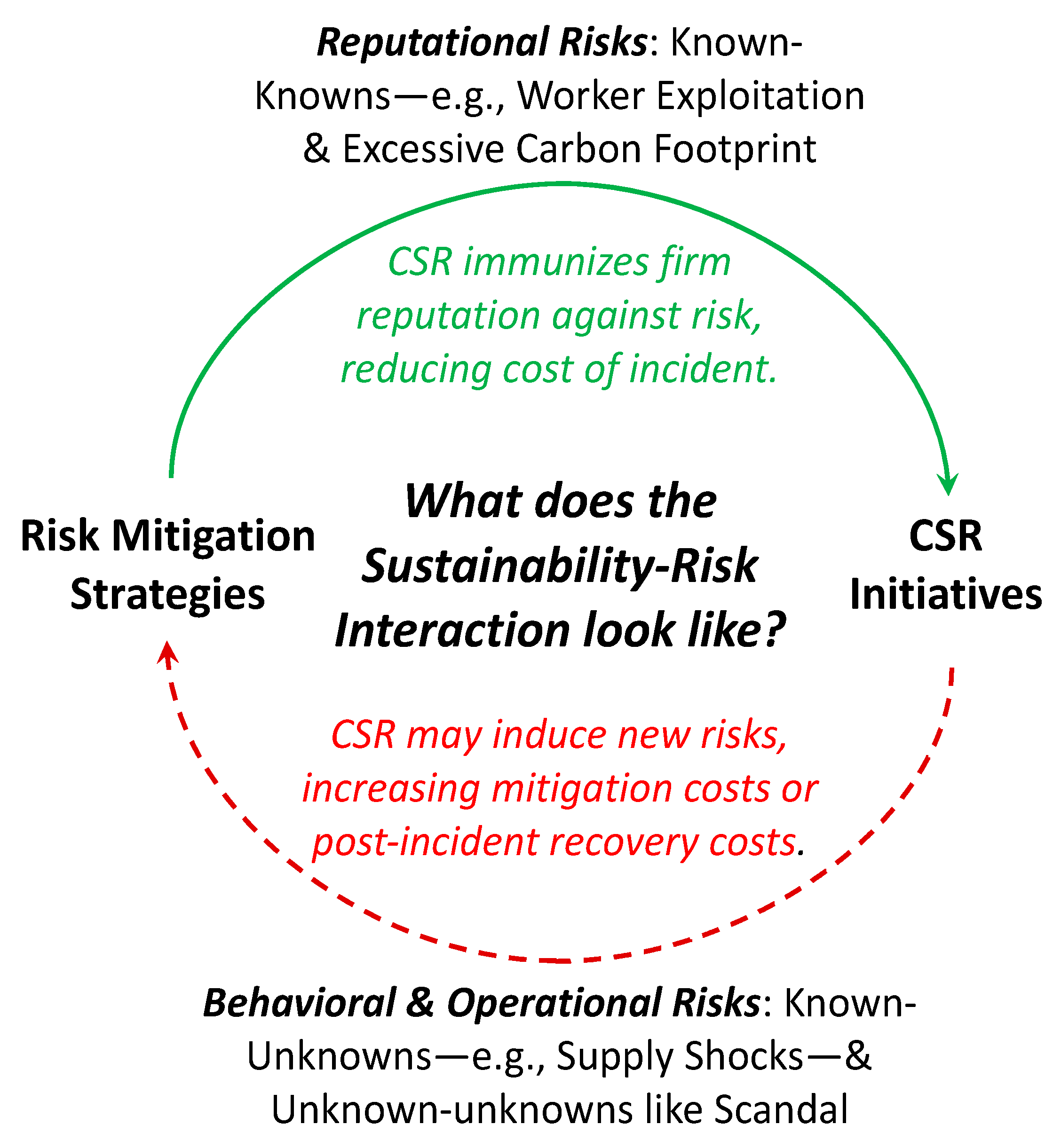
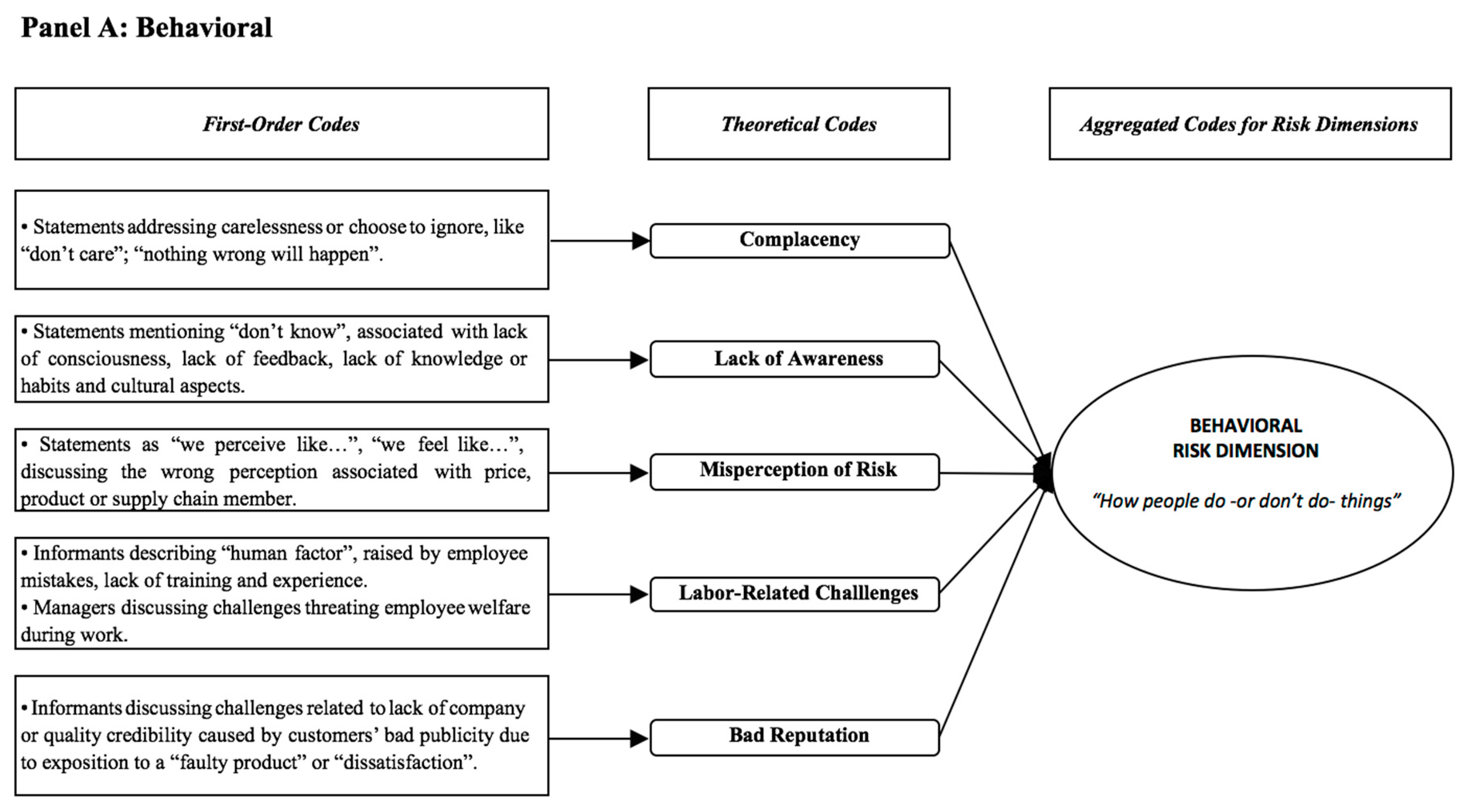
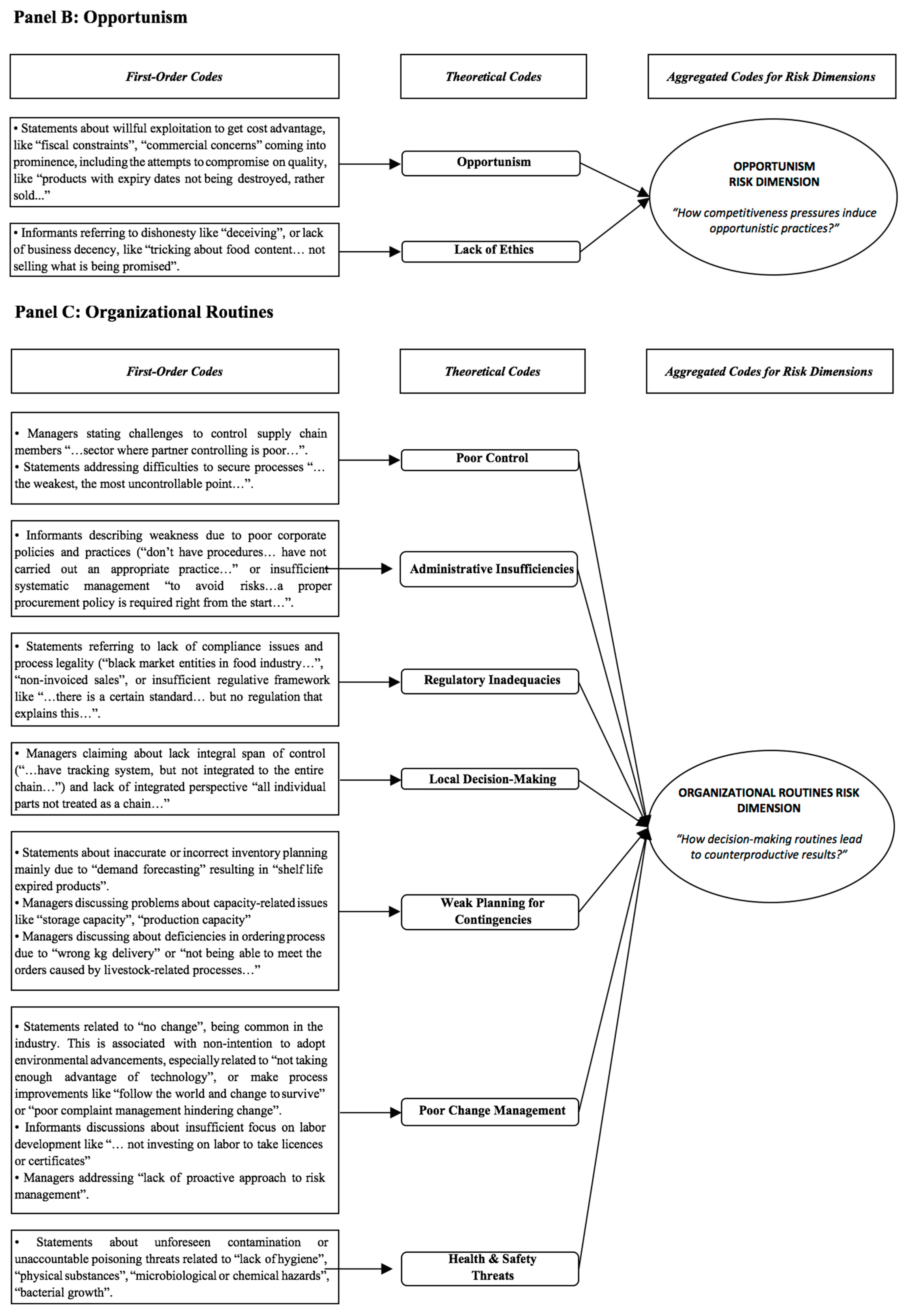
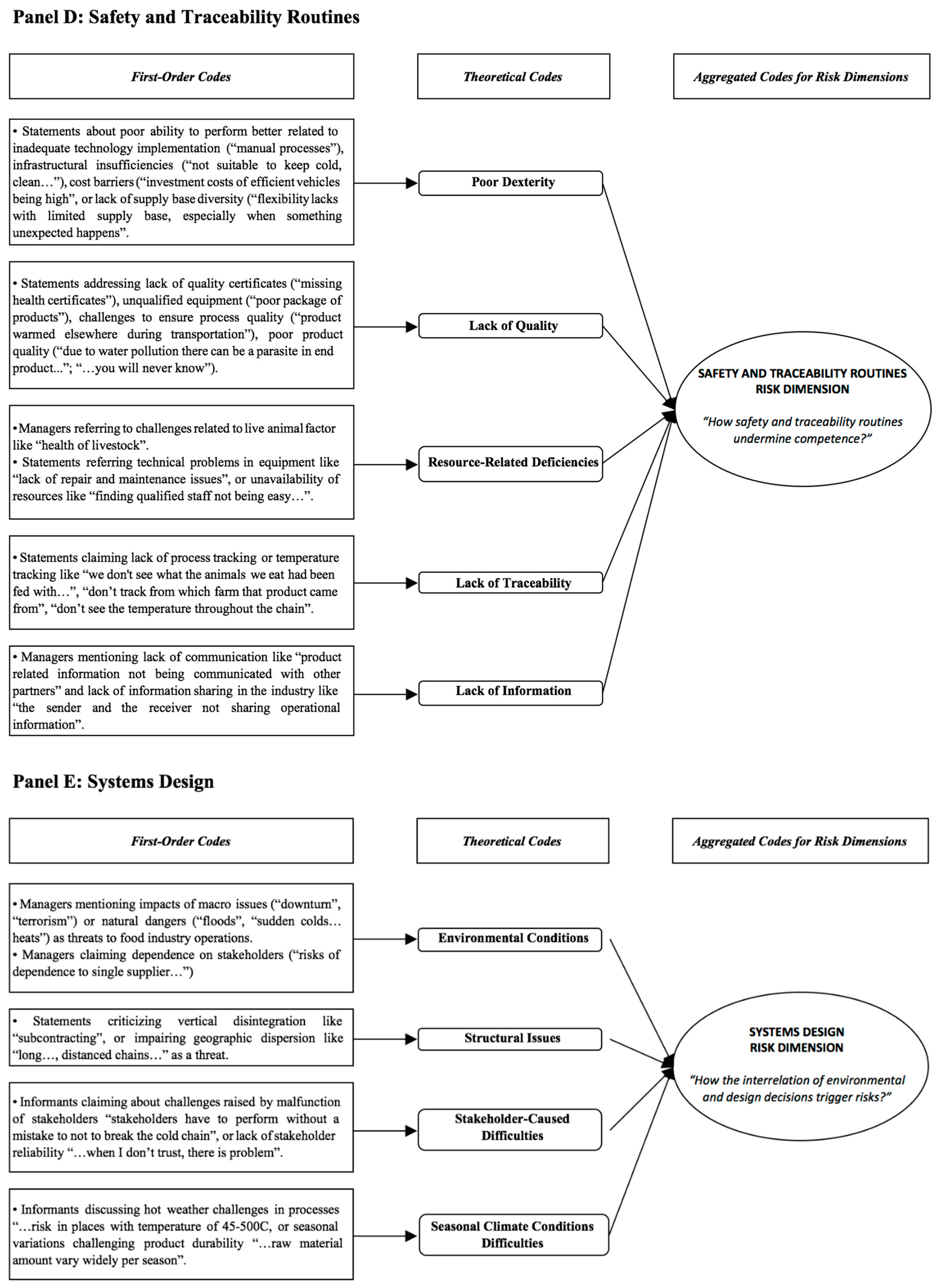
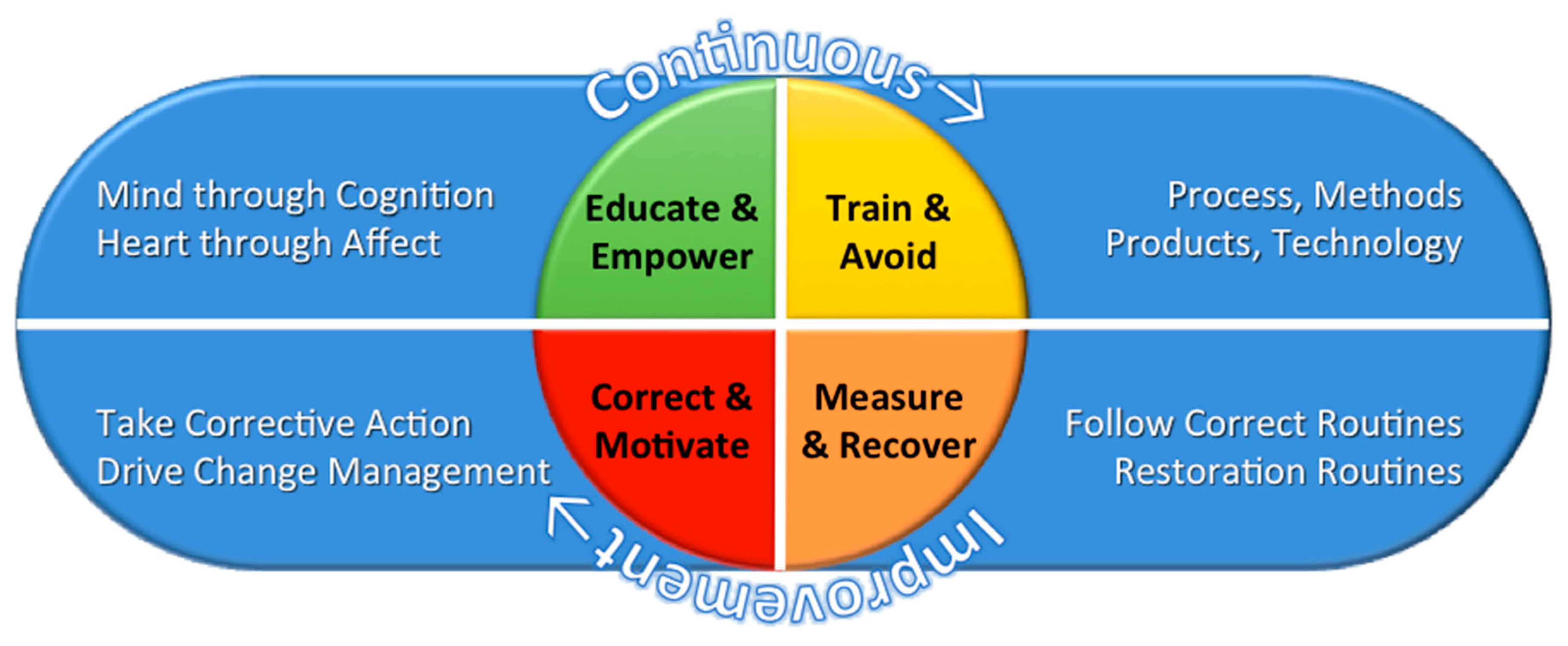
| Risk Type | |
|---|---|
| Known-Knowns | Disruptive events that occur fairly frequently; i.e., they possess a track record. Data exists to assess probability they will occur and the severity of their impact. Commonly discussed in the literature. |
|
|
| Known-Unknowns | Disruptive events that have happened in the past, but without a consistent pattern or history, making assessment speculative. Specific events discussed as case studies in the literature. |
|
|
| Unknown-Unknowns | Conceivable but unusual and unexpected events. As rare—even surprising—events, these black swan have a major effect on operations. Literature is less developed; i.e., more ad hoc and fragmented. |
| |
| Supply Chain Position | Food Product Supply Chain Types at Which They Are Considered as Exemplars | Number of Employees (Approximately) | Number of Interviews (Observation) | Positions of Interviewees |
|---|---|---|---|---|
| Service Providers | ||||
| Road Transportation | DP, C | 160 | 2 (1) | General Manager, Logistics Manager |
| Road Transportation | DP, C | 170 | 1 (1) | General Manager |
| Road Transportation | RF | 160 Turkey, 5000 Global | 1 (1) | General Manager |
| Maritime Transportation | F | +300 GL | 1 | General Manager |
| Air Transportation | F | 500 | 1 (1) | Air Cargo Supervisor |
| Distributor | ||||
| Distribution Center | M | 55 Aegean Region, 1800 Turkey | 1 (1) | Warehouse Specialist |
| Sales & Distribution | DP | 68 | 1 (1) | Sales Manager |
| Sales & Distribution | F | 456 | 1 | Sales Manager |
| Dealer | DP | 25–30 | 1 (1) | Dealer Manager |
| Research Center | ||||
| Food Quality Laboratory | All | 124 | 1 | General Manager |
| Total | 10 | 11 (7) | ||
| Material Suppliers | ||||
| Processing Plant (Farm) | F | 151 | 1 (1) | Plant Manager |
| Processing Plant (Meat Processing) | M | 250 | 1 (1) | Quality Control Manager |
| Processing Plant (Farm) | DP | 40–45 | 1 (1) | Plant Manager |
| Total | 3 | 3 (3) | ||
| Finished Goods Producers | ||||
| Manufacturer | C | 2000 | 1 (1) | Quality Control Manager |
| Manufacturer | D | 110–115 | 2 (1) | Quality Control Manager, Manufacturing Manager |
| Manufacturer | F | 456 | 1 (1) | Logistics and Planning Manager |
| Manufacturer | F | 49 | 1 (1) | Quality Control Expert |
| Manufacturer | M | 900 Factory, 1800 Turkey | 3 (1) | Quality Control Manager, Logistics Manager, Warehouse Manager |
| Total | 5 | 8 (5) | ||
| Retailers | ||||
| Retailer | DP, M, C | 2 | 1 (1) | Grocery Manager |
| Retailer | DP, M, C | 3 | 1 (1) | Grocery Manager |
| Retailer | DP, M, C | 21000 | 1 (1) | Supermarket Chain Manager |
| Retailer | F, DP, M, C | 21000 | 1 (1) | Supermarket Chain Responsible |
| Restaurant | F, DP, M, C | 100 | 1 (1) | Restaurant Manager |
| Restaurant | RF | 262, in total | 1 (1) | Food Country Manager |
| Restaurant | RF | 50, in İzmir Branch | 1 (1) | Food Branch Manager |
| Restaurant | F, DP, M, C | 38 | 1 | Restaurant Manager |
| Total | 8 | 8 (7) | ||
| COMPANIES | 26 | 30 (22) | ||
| Context | ||||
| Consumer | All | 1 | Consumer | |
| Consumer | All | 1 | Consumer | |
| Consumer | All | 1 | Consumer | |
| Consumer | All | 1 | Consumer | |
| Consumer | All | 1 | Consumer | |
| Consumer | All | 1 | Consumer | |
| Consumer | All | 1 | Consumer | |
| Consumer | All | 1 | Consumer | |
| Consumer | All | 1 | Consumer | |
| Consumer | All | 1 | Consumer | |
| Academician | All | 1 | Professor of Culinary Arts and Management | |
| Food Safety Association | All | (1) | Quality Managers | |
| Food market | F | (1) | Owners and Operators | |
| Food market | F | (1) | Owners and Operators | |
| Food market | DP | (1) | Owners and Operators | |
| Food market | RF (incl. F, M, C) | (1) | Operators | |
| Food market | RF (incl. F, M, C) | (1) | Operators | |
| CONTEXT | 17 | 11 (6) | ||
| MAIN TOTAL | 43 | 41 (28) | ||
| Test | Implementation in Food Supply Chain Case Study and Content Analysis |
|---|---|
| Internal Validity | Multiple food product types are selected Cases included semi-structured interviews and observations Different relationships are examined among different levels of supply chain members Discussed and documented interviews. |
| Construct Validity | Multiple sources of evidence are explored in multiple food product type studies, a chain of evidence is established and the case report is discussed by three key respondents Used informants with different perspectives and conflicting interests which are also from different organizational levels belonging different food product chain types Two key informants reviewed the case report Multiple documents are collected and reviewed A great attention is given on the sampling design and analysis. |
| External Validity | Multiple food product types are studied Used and followed a case study protocol throughout the case study Created a case study database. |
| Reliability | All interviews are recorded in good-quality, transcribed into text format in details Case study protocol is used to document the procedures followed, and the complete operational process and case study database is formed Multiple coders analyzed transcript data to check whether the codes and themes are coded the same way as in the analysis The coding and interpretation process is checked by three academicians on the field and the extent to which they have arrived at the same findings is reported Reproductivity is reported through discursive alignment of interpretation. |
| Risk Factor | Power Quote | Proof Quote |
|---|---|---|
| Complacency: Any risk factor related to passivity or complacency of individuals. | “Distributors drop off goods on the streets … at 50 degrees. The product is delivered to the store without air conditioning. The product is put in the refrigerator again. Then the customer buys it and puts it into bags at 45 degrees … and carries it around for 3–4 h. S/he goes home and puts it in refrigerator again. These are the conditions in Turkey. We, as Turkish people, think like ‘nothing bad will happen’”. “Product is spoilt because our people just don’t care enough”. | “Nothing bad will happen. We feel like it doesn’t matter”. “Anything can happen! But they don’t care”. |
| Lack of Awareness: Any risk factor related to the lack of consciousness and attention, or negligence regarding critical issues. | “First, we need to be aware as consumers … because … we are both producers and consumers. You are going to the factory … as the manager, the producer. Then you go home at night; buy products from the supermarket as a consumer. First, we need to be a conscious society”. “There are studies on sustainability … but the education level is quite low. [It’s] all about insufficient awareness; since we don’t understand and know about hazardous consequences, we don’t contribute”. “In Turkey, we want to get every job done fast. This is our culture. And this is how managers decide and what they measure. They don’t know or care about the rest! Anything can happen!” | “Too many unaware people work in the food sector.” “The consumer is not aware, doesn’t know anything.” |
| Misperception of Risk: Any risk factor that falsely affects the perception of individuals, resulting in a failure to deliver expected value. | “Red gills in a fish is perceived as freshness. But the story is different. If that fish waits in water for a day, the blood in the gills passes into the water. There you have white gills. When we sell it, this becomes a huge problem. Your customer conducts quality control, sees the white gills … no matter how good the meat quality is … they perceive it as dated. You cannot sell that fish because of this false perception”. | “[Consumers] perceive the natural one is the local one sold by villagers”. “They perceive it as expensive. It is NOT; it costs what it’s worth”. |
| Labor-related Challenges: Any risk factor associated with labor activities | “The human factor is very important surely. If you consider companies, they make incredible investments in quality and laboratories. But when you consider drivers, you know, we are all human. However, it is the driver who completes the entire chain, not the company itself”. “When the human factor is involved, it makes things more difficult. People all make mistakes; minimizing this is crucial”. | “You can design everything perfect … but humans … cannot be perfect”. “A flaw may arise due to personnel”. |
| Bad Reputation: Any risk factor related to failing to build a true image or confidence in the opinion of stakeholders. | “Loss of customer confidence will generate a bad reputation for them. Not only will they lose reputation in the eyes of the customers, but it will also be bad publicity compared to their competitors, and thus they will face such an integrated and sophisticated effect. They may even lose the market; in the most extreme situation, they may go bankrupt”. | “If you provide a faulty product that affects your image in the eyes of the customer”. “You can dissatisfy people once; there is NO second time”. |
| Risk Factor | Power Quote | Proof Quote |
|---|---|---|
| Opportunism: Any risk factor arising from supply chain partners’ self-interested efforts to exploit. | “He doesn’t switch on the cooler to save the costs of consuming oil fuel”. “Unfortunately, food safety is usually ignored since economic factors predominate”. | “For commercial greed, even big brands administer antibiotics, 3 days after they slaughter the chickens”. “Opportunism is everywhere in this sector”. |
| Lack of Ethics: Any risk factor caused by violation of ethics or compliance. | “Some run the following scam: they cover eggs with hay and sell them as village eggs. However, maybe they were produced by the most antibiotics-vaccinated hen”. “The biggest risk is tricks in the production: the use of pork meat instead of beef … even the producer begins deceiving you”. “It is related to ethics. If it is chicken sausage, it needs to be hundred percent chicken. Implementing what you have promised is ethical”. | “The greed of people”. “These frauds start from production”. “They said this minced meat is spoiled, that it smells. He was already a cunning man, put it in deliberately”. |
| Risk Factor | Power Quotes | Proof Quotes |
|---|---|---|
| Poor Control: Any risk factor related to lack of detection of important errors | “Big supermarkets are audited … but small supermarkets, groceries, open markets are not. However, the big threat comes from small-scale ones … because big brands manage their risks to protect brand value”. “I don’t control sub-suppliers. It should be done but it is obviously a big thing. I’ve never heard of anyone doing it. This is something complicated”. | “No audits related to cold chain”. “It is a sector where partner monitoring is poor”. “It becomes less well-monitored when it gets closer to the end user”. |
| Administrative Insufficiencies: Any risk factor caused by failures in developing the procedures for performing activities and arrangements to run a business | “Of course, risks do exist…but when you establish rules from the beginning and implement them strictly and properly, this is reflected in our own personnel. When they see this attention in terms of management and the organization, it is reflected in the practices of the producer, and the seller”. “Food safety is something that can be managed. What is important here is to accurately build and follow procedures, predict risks and prevent them. Struggling with risks, avoiding risks, requires a proactive approach, not reactive”. | “Social responsibility procedures are very deficient”. “If you don’t have procedures, you will not be able to manage numerous products”. |
| Regulatory Inadequacies: Any risk factor related to the lack or non-enforcement of regulations | “There are many black-market entities in the market. It leads to unfair competition”. “I am confident that companies will approach it differently if legal sanctions are implemented strictly.” | “The food market should better be regulated”. “The problem is non-invoiced sales. Turkey is still behind in such commercial matters”. |
| Local Decision-Making: Any risk factor caused by the lack of a holistic perspective in supply chains | “There should be a risk management department in individual members. They should cooperate with each other…but companies don’t perceive it as supply chain”. “Companies need to know the stages before and after themselves, and if they do not look at the entire chain holistically, there is no sustainability in their supply chains”. | “We have tracking system but it is not integrated into the entire chain”. “It starts from the fish feed and continues up to the customer. I should not exclude anything”. |
| Weak Contingency Planning: Any risk factor caused by the inability to plan for the unexpected | “Milk is not an item that can be stocked. We should produce milk today then dispatch it within 24 hours. You have no chance to sell it after that”. “We have capacity problems in overseas air transportation. We met with an airline. They can’t say it can be fixed in the short term”. | “One of risks is poor planning”. “Demand forecasting is crucial. The more mistakes on your forecast, the more the food may be spoiled”. |
| Poor Change Management: Any risk factor related to the inability and resistance to change | “If you can’t receive a customer complaint, this is a risk for us because if that complaint can’t ever reach me, I can’t take any precautions to prevent this. Maybe I’ve been making a mistake in my process that I couldn’t see before, because risk is at any point”. “It is critically important to change. We do implement changes … but this is not common in the industry”. | “If you improve, you eliminate risk in any business”. “You should not keep up with contemporary technology; you should follow the world”. |
| Health & Safety Threats: Any risk factor threatening the health and safety of any individual | “What we call hygiene is the prevention of biological infections, such as personal hygiene, environmental hygiene. The cold chain alone is not enough; hygiene plus cooling is a must”. “If someone with any disease is working in production, when that person contaminates the food, millions of microbes can infect millions of people and it might pose a serious risk”. | “There are physical substance dangers”. “The risk of illness in animals is very important as it can contaminate the food”. |
| Risk Factor | Power Quote | Proof Quote |
|---|---|---|
| Poor Dexterity: Any risk factor that prevents a supply chain from performing an action skillfully, quickly and effectively. | “It is not only the food; the biggest threat is the flexibility of the supply chain. We have seen during the crises that even the best supply chains may collapse … because they think that they built them up perfectly. However, when something unexpected happens, they cannot respond with the same flexibility”. | “It is not easy to detect what happens in transit if you don’t have an online monitoring system”. “We issue waybills manually. This reduces productivity and is open to errors”. |
| Lack of Quality: Any risk factor related to the failure to meet expectations regarding a product or service. | “The quality of the raw material is the priority. You cannot make a quality product from poor quality raw materials”. “Antibiotics and hormones given to Animals damages food quality”. | “Carriers don’t have quality certificates”. “The delivery process cannot guarantee protecting the quality of products”. |
| Resource-related Deficiencies: Any risk factor related to non-functionality, uncertainty, failure or lack of resources. | “If you have your own fish, you take a livestock risk. It is one of our biggest risks at sea”. “Not supplying the raw material is the biggest obstacle for that chain. In the food sector, companies have supply difficulties; that’s actually a risk”. | “You need to have a good vet, good equipment and a clean place to avoid risks”. “To find qualified staff is not easy in this sector”. |
| Lack of Traceability: Any risk factor caused by problems in following, tracking and tracing the logistics activities of a product, an activity or a process, without clear information. | “We have to trace the processes. Even the traceability of a sheep gut casing is important. When there is bacterial load, e.g., in sausage, it needs to be pulled from the market: which sheepskins were used on the sausages, which companies supplied them, and which companies were they distributed to? We need to know which sausages to pull from the shelves. It would be a huge loss for us to pull the entire production. Traceability is critical, especially in food companies”. | “We don’t know what we eat; we can’t track what the animals we eat were fed on”. “The biggest risk is heat values of products, and we have to track them”. |
| Lack of Information: Any risk factor preventing the dissemination of complete, readily-available, consistent, visible, accurate and secure information. | “The consumer must absolutely be informed as part of social responsibility to avoid potential hazards. We see public service ads, e.g., ‘Don’t smoke’, but don’t see ads like ‘Don’t put food back in the fridge once it is dissolved”. “We have to know the exact details of the product in the customs office. I mean the customer side and our side have to be very well integrated to not break the cold chain. Lack of information sharing is this risk”. | “Customer-manufacturer communication is critical to avoid spoilage”. “There is no expiry date information on the product package after opening. However, this is important”. |
| Risk Factor | Power Quote | Proof Quote |
|---|---|---|
| Environmental Conditions: Any risk factor associated with larger external forces addressing a failure or negativity of a system effect | “Supply chain risks resulting from environmental factors are also relevant here. During a global downturn or terrorism, you are subject to market and price risks …”. “For example, Bulgaria closed its customs because of documentation issues. Our vehicles waited 3 days. It is a big cost to us. | “We depend on imports in the feed industry”. “When you work with a single supplier, there are risks of dependence”. “Natural disasters are big risks, especially in agriculture and livestock. |
| Structural Issues: Any risk factor caused by internal or external structures of supply chains | “The biggest danger is subcontractors; e.g., subcontracted dealers might sell out-of-date products. We experience that a lot”. “Distance is risky in my opinion. Production facilities should be as close to the customers as possible”. “The reason why it cannot keep up with change and be flexible is that the supply chain is a part of so many other chains, with several members”. | “The biggest danger is outsourcing”. “… The longer the chain, the harder it is …”. |
| Stakeholder-caused Difficulties: Any risk factor caused by stakeholder activities and reliability | “The first and last link of the chain: the biggest dangers are happening there”. “The biggest risk is the last sales point in the market, I mean markets, shops, etc. where the cold chain ends. They are not protecting the cold chain sufficiently”. “It is very important to work with stakeholders that we believe perform well”. | “The riskiest group is the grocery stores, the restaurants: the last point”. “Your carrier has to transport without one mistake to not break the cold chain”. |
| Seasonal Climate Conditions: Any risk factor associated with seasonal variations | “There is cold storage in airports…but in places with temperatures of 45–50 °C, sometimes there are de-icing incidences”. “Milk can vary widely depending on the season. For example, the temperature you ferment the yogurt or cheese in summer is different from the temperature you ferment the yogurt in winter. Even southwest winds immediately affect the milk’s quality”. | “The risk is more in summer”. “Seasonal changes create problems”. “We increase the salt ratio on fish in summer … or it melts …”. |
| Research Question | Findings |
|---|---|
| Does sustainability introduce new and unexpected risks into food supply chains? | We found 61 distinct risk elements, which compose five theoretical risk dimensions. |
| If so, what is the nature of these sustainability-induced risks? | Sustainability-induced risks are embedded in employee behavior, influencing not just systems design, but also organizational and food safety routines. |
| How do sustainability and risk interact to influence managerial decision making and ultimately the viability of sustainability programs? | Sustainability-induced risks raise both actual and potential costs. Managers, however, tend to ignore many of these risks, increasing the likelihood of disruption. |
© 2018 by the authors. Licensee MDPI, Basel, Switzerland. This article is an open access article distributed under the terms and conditions of the Creative Commons Attribution (CC BY) license (http://creativecommons.org/licenses/by/4.0/).
Share and Cite
Göçer, A.; Fawcett, S.E.; Tuna, O. What Does the Sustainability-Risk Interaction Look Like? Exploring Nuanced Relationships in Emerging Economy Sustainability Initiatives. Sustainability 2018, 10, 2716. https://doi.org/10.3390/su10082716
Göçer A, Fawcett SE, Tuna O. What Does the Sustainability-Risk Interaction Look Like? Exploring Nuanced Relationships in Emerging Economy Sustainability Initiatives. Sustainability. 2018; 10(8):2716. https://doi.org/10.3390/su10082716
Chicago/Turabian StyleGöçer, Aysu, Stanley E. Fawcett, and Okan Tuna. 2018. "What Does the Sustainability-Risk Interaction Look Like? Exploring Nuanced Relationships in Emerging Economy Sustainability Initiatives" Sustainability 10, no. 8: 2716. https://doi.org/10.3390/su10082716
APA StyleGöçer, A., Fawcett, S. E., & Tuna, O. (2018). What Does the Sustainability-Risk Interaction Look Like? Exploring Nuanced Relationships in Emerging Economy Sustainability Initiatives. Sustainability, 10(8), 2716. https://doi.org/10.3390/su10082716




